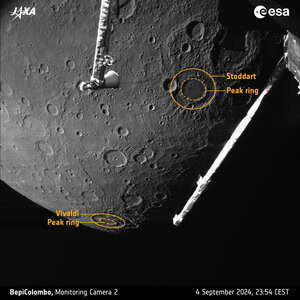Accept all cookies Accept only essential cookies See our Cookie Notice

About ESA
The European Space Agency (ESA) is Europe’s gateway to space. Its mission is to shape the development of Europe’s space capability and ensure that investment in space continues to deliver benefits to the citizens of Europe and the world.
Highlights
ESA - United space in Europe
This is ESA ESA facts Member States & Cooperating States Funding Director General Top management For Member State Delegations European vision European Space Policy ESA & EU Space Councils Responsibility & Sustainability Annual Report Calendar of meetings Corporate newsEstablishments & sites
ESA Headquarters ESA ESTEC ESA ESOC ESA ESRIN ESA EAC ESA ESAC Europe's Spaceport ESA ESEC ESA ECSAT Brussels Office Washington OfficeWorking with ESA
Business with ESA ESA Commercialisation Gateway Law at ESA Careers Cyber resilience at ESA IT at ESA Newsroom Partnerships Merchandising Licence Education Open Space Innovation Platform Integrity and Reporting Administrative Tribunal Health and SafetyMore about ESA
History ESA Historical Archives Exhibitions Publications Art & Culture ESA Merchandise Kids Diversity ESA Brand CentreSpace in Member States
Find out more about space activities in our 23 Member States, and understand how ESA works together with their national agencies, institutions and organisations.
Science & Exploration
Exploring our Solar System and unlocking the secrets of the Universe
Go to topicAstronauts
Missions
Juice Euclid Webb Solar Orbiter BepiColombo Gaia ExoMars Cheops Exoplanet missions More missionsActivities
International Space Station Orion service module Gateway Concordia Caves & Pangaea BenefitsLatest
Space Safety
Protecting life and infrastructure on Earth and in orbit
Go to topicAsteroids
Asteroids and Planetary Defence Asteroid danger explained Flyeye telescope: asteroid detection Hera mission: asteroid deflection Near-Earth Object Coordination CentreSpace junk
About space debris Space debris by the numbers Space Environment Report In space refuelling, refurbishing and removingSafety from space
Clean Space ecodesign Zero Debris Technologies Space for Earth Supporting Sustainable DevelopmentSpace weather
Space weather and its hazards ESA Vigil: providing solar warning ESA Space Weather Service NetworkLatest
Applications
Using space to benefit citizens and meet future challenges on Earth
Go to topicObserving the Earth
Observing the Earth Future EO Copernicus Meteorology Space for our climate Satellite missionsCommercialisation
ESA Commercialisation Gateway Open Space Innovation Platform Business Incubation ESA Space SolutionsLatest
Enabling & Support
Making space accessible and developing the technologies for the future
Go to topicBuilding missions
Space Engineering and Technology Test centre Laboratories Concurrent Design Facility Preparing for the future Shaping the Future Discovery and Preparation Advanced Concepts TeamSpace transportation
Space Transportation Ariane Vega Space Rider Future space transportation Boost! Europe's Spaceport Launches from Europe's Spaceport from 2012Latest


BepiColombo captures newly named Stoddart crater
Thank you for liking
You have already liked this page, you can only like it once!
The sunlit part of Mercury comes into view at the top right of this image, taken at 23:54 CEST on 4 September 2024 as the ESA/JAXA BepiColombo mission sped by for its fourth of six gravity assist manoeuvres at the planet.
The image was captured by the Mercury Transfer Module’s monitoring camera 3 (M-CAM 3), when the spacecraft was about 555 km from the planet’s surface. The spacecraft’s closest approach of 165 km took place at 23:48 CEST.
The surface of Mercury hosts many fascinating geological features. Of special note is the Stoddart peak ring basin: a mysterious 155-km wide impact crater that had no name, until last month.
When the BepiColombo M-CAM team were planning for this flyby, they realised that this crater would be visible and decided it would be worth naming due to its potential interest for BepiColombo scientists in the future.
Following a request from the M-CAM team, the ancient crater was recently assigned the name Stoddart by the International Astronomical Union’s Working Group for Planetary System Nomenclature, after Margaret Olrog Stoddart (1865–1934), an artist from New Zealand known for her flower paintings.
The back of the Mercury Planetary Orbiter’s high-gain antenna and part of the spacecraft’s body are also visible in front of Mercury in this image. Mercury Planetary Orbiter is one of two orbiters that will separate from the carrier spacecraft following arrival in orbit around Mercury.
North is to the upper left.
More about BepiColombo's fourth Mercury flyby
Click here for an annotated version of this image
[Image description: Planet Mercury in the background with its grey, cratered, pock-marked surface. In the foreground are some spacecraft parts]
-
CREDIT
ESA/BepiColombo/MTM -
LICENCE
CC BY-SA 3.0 IGO or ESA Standard Licence
(content can be used under either licence)

BepiColombo captures newly named Stoddart crater (annotated)

BepiColombo’s fourth Mercury flyby

Mercury: Lord of the (peak) Rings (annotated)

Fly over Mercury with BepiColombo















 Germany
Germany
 Austria
Austria
 Belgium
Belgium
 Denmark
Denmark
 Spain
Spain
 Estonia
Estonia
 Finland
Finland
 France
France
 Greece
Greece
 Hungary
Hungary
 Ireland
Ireland
 Italy
Italy
 Luxembourg
Luxembourg
 Norway
Norway
 The Netherlands
The Netherlands
 Poland
Poland
 Portugal
Portugal
 Czechia
Czechia
 Romania
Romania
 United Kingdom
United Kingdom
 Slovenia
Slovenia
 Sweden
Sweden
 Switzerland
Switzerland

























